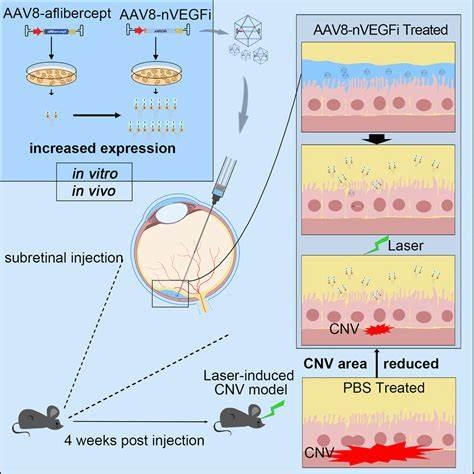Gene Therapy for Age-Related Macular Degeneration: A New Era in Vision Care
Age-related macular degeneration (AMD) is a leading cause of irreversible vision loss among the elderly, with projections estimating nearly 290 million affected individuals by 2040. The disease manifests in two advanced forms: atrophic (dry) and exudative (wet or neovascular AMD, nAMD). While anti-VEGF therapies have revolutionized nAMD treatment, their frequent administration poses challenges. Gene therapy emerges as a promising alternative, aiming for sustained therapeutic effects with reduced treatment burdens.
Understanding AMD and Current Treatments
In nAMD, abnormal blood vessel growth (macular neovascularization) leads to rapid central vision loss. Anti-VEGF agents like ranibizumab, aflibercept, and bevacizumab inhibit vascular endothelial growth factor (VEGF), curbing this neovascularization. However, the necessity for monthly or bimonthly intravitreal injections burdens patients and healthcare systems alike. Non-adherence can result in suboptimal outcomes, and some patients exhibit inadequate responses to these therapies.
Gene Therapy: A Paradigm Shift
Gene therapy introduces genetic material into retinal cells, enabling continuous production of therapeutic proteins. This approach promises prolonged efficacy, potentially reducing or eliminating the need for repeated interventions. Adeno-associated viruses (AAVs) are commonly used vectors due to their low immunogenicity and ability to transduce non-dividing cells.
Key Gene Therapy Approaches for AMD:
-
Anti-VEGF Gene Therapy: Genes encoding anti-VEGF proteins are delivered to retinal cells to ensure sustained VEGF suppression.
-
Complement Inhibitors: Targeting complement factor H (CFH) and I (CFI) to modulate the complement pathway, implicated in AMD pathogenesis.
-
Angiogenesis Inhibitors Beyond VEGF: Expressing proteins like endostatin and angiostatin to inhibit abnormal blood vessel growth.
Prominent Gene Therapy Candidates
RGX-314 (Regenxbio)
An AAV8-based gene therapy expressing a ranibizumab-like protein. Phase 3 trials have demonstrated sustained VEGF suppression with reduced treatment burden. In 2023, Regenxbio reported that RGX-314 was well-tolerated in 46 patients, with stable or improved visual acuity and decreased central retinal thickness.
ADVM-022 (Adverum Biotechnologies)
Utilizes an AAV.7m8 vector to deliver aflibercept. Early trials indicate long-term VEGF inhibition. A single intravitreal injection could potentially eliminate the need for ongoing treatments.
RetinoStat (Oxford BioMedica)
A lentiviral vector expressing angiostatin and endostatin. Completed phase 1 trials with sustained transgene expression.
Delivery Methods: Navigating the Options
Gene therapy can be administered via:
-
Intravitreal Injection: Minimally invasive, delivering vectors into the vitreous humor.
-
Subretinal Injection: Targets the retinal pigment epithelium (RPE) and photoreceptor cells directly, ensuring high transduction efficiency but requires vitrectomy.
-
Suprachoroidal Injection: A novel, less invasive route delivering therapy between the sclera and choroid.
Challenges and Future Directions
While gene therapy offers promising avenues, challenges persist:
-
Immune Response: AAV-mediated therapies can elicit immune reactions, necessitating immunosuppressive strategies.
-
Long-Term Safety: Sustained gene expression may have off-target effects, requiring careful monitoring.
-
Cost: High development and production costs raise concerns about accessibility.
Future directions include gene-editing approaches like CRISPR-Cas9 to precisely modify AMD-associated genetic variants and combination therapies integrating gene and cell-based strategies for enhanced neuroprotection and retinal repair.
Conclusion
Gene therapy represents a revolutionary approach to AMD management, offering sustained therapeutic effects with reduced treatment burdens. Advancements in vector design, gene targets, and delivery methods continue to enhance its feasibility and efficacy. While challenges remain, ongoing clinical trials and technological innovations hold the promise of transforming AMD treatment paradigms in the near future.





